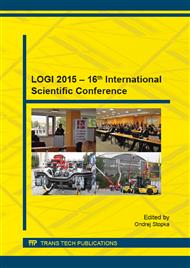p.3
p.9
p.17
p.24
p.33
p.40
p.47
p.54
Public Transport Preference as the Tool to Manage Traffic Flow and to Increase Service Quality from a Customer Point of View
Abstract:
The increase of individual car traffic causes that existing transport networks fail to meet the needs of road traffic in the means of capacity. One of the possible options for solving this problem is the construction of new communications. This solution is difficult to implement due to the high investment costs and possibility for further development. Therefore, one of the options for avoiding this problem is to make public urban transport more attractive, for example, through its support and preference. One of the main criteria in the quality evaluation of public urban transport is the transfer speed from origin to destination. This speed can be most noticeably affected by the use of public urban transport preference.This paper will discuss the analysis of passengers’ satisfaction with services provided by carriers of urban transport and the possibilities of public urban transport preference through the preference of public urban transport vehicles in reserved traffic lanes and on signal controlled intersections.
Info:
Periodical:
Pages:
17-23
Citation:
Online since:
October 2015
Authors:
Keywords:
Price:
Сopyright:
© 2015 Trans Tech Publications Ltd. All Rights Reserved
Share:
Citation:


